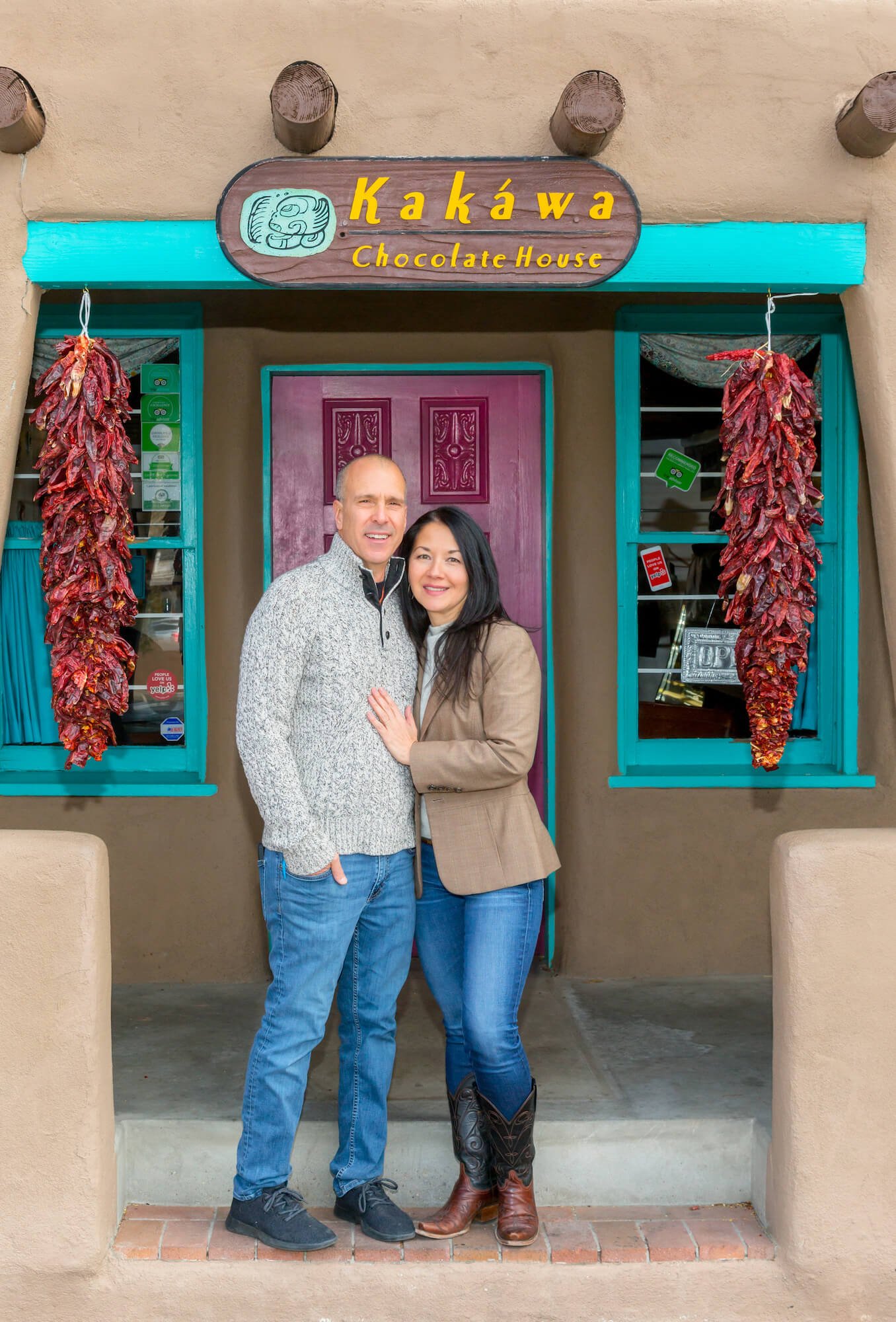Why Kakawa Chocolate House Makes 18 Different Delectable Chocolate Elixirs
Bonnie and Tony in front of shop photo credit Daniel Quat Photography
Many chocolatiers offer a hot chocolate, sometimes a few variations on the theme, but Kakawa Chocolate House goes far beyond that. And for good reason. “Most people don’t have an understanding of how old chocolate is,” says Bonnie Bennett, co-owner of Kakawa Chocolate House. “It’s been consumed as a beverage for thousands of years. Eating chocolate is much more recent history.” Bennett and her husband Tony (“We’re self-proclaimed chocolate nerds”) have been running Kakawa in Santa Fe, New Mexico since the early 2000s. They have also expanded to multiple Santa Fe locations and a shop in Salem, Massachusetts.
“We are an artisan chocolate maker founded on the long history of chocolate,” Bennett says. “For us, what that means is continuing to educate people, and perpetuating the long history and the chocolate recipes we are representing. I call it time traveling for the palate.”
Chocolate Elixirs
She explains that Kakawa’s main focus is their 18 different chocolate elixirs: thick, rich concoctions inspired by the beverages consumed by indigenous peoples, historic European sipping chocolates, and contemporary flavors from around the world. The elixirs are served in-store as prepared beverages and are also available in a packaged format to prepare at home.
The Mesoamerican elixirs represent the original culinary uses of chocolate. Dating back at least 3,500 years, indigenous Mesoamerican peoples (including the Olmecs, Toltecs, and later, the Mayans and Aztecs) ground up cacao beans and added spices, chiles, herbs, and water to create intense, chocolaty drinks. The recipes for Kakawa’s Mesoamerican elixirs are based on the work of food anthropologists. Made with little to no sweetener, most are flavored with chili, spices, nuts, and herbs. For example, the Chili Elixir contains unsweetened chocolate, agave nectar, ancho chili, and vanilla.
“It’s always fun to see people experience something really unique,” says Bennett. “Like the Mayan Full Spice Elixir, with 16 different herbs and spices. It’s so unusual, there’s not anything like it.”
The historic European chocolate elixirs will taste more familiar to modern palates. The 1666 Italian Citrus Elixir is representative of the beverages enjoyed in the Tuscan court from the 1660s through the late 1700s, and is made with 70% chocolate, lemon and orange zest, cinnamon, and vanilla. The 1775 Marie Antionette Elixir is based on the recipe the queen brought with her from Vienna to the French court, and includes orange blossom water.
Kakawa’s contemporary elixirs incorporate a wide range of global flavors, from a Modern Mexican Elixir that reflects a preference for milkier, sweeter beverages, to a Chocolate Chai Elixir with a housemade spice blend. The Havana Rum Elixir was developed in collaboration with a Cuban chef (the alcohol is cooked off during processing).
“We have a little something for everyone,” says Bennett. “[Our elixirs] go through everything from bold and complex to very sweet and more contemporary kinds of flavors.”
Chocolate Confections
Photo credit Kakawa Chocolate House
In addition to elixirs, Kakawa Chocolate House crafts truffles, solid chocolates, caramels, and organic ice cream. Bennett notes that those products offer more room for creativity, since they aren’t based on historic recipes. For example, the shop’s signature truffle features goat cheese and sage. Many products incorporate local flavors, including the caramels, which are sweetened with agave and flavored with locally grown ingredients including piñon (similar to pine nuts), lavender, and New Mexico green and red chiles.
Chocolate lovers who aren’t able to travel to Kakawa’s physical locations can place orders online, weather dependent. (During extreme heat shipping may be temporarily suspended to ensure that chocolates arrive intact.)
“We have a lot of appreciation for the locals and amazing customers around the country who placed big orders for shipping [during the pandemic] to make sure we’d still be around when they’re able to travel back to Santa Fe,” says Bennett. “We’re grateful to still be here and be able to continue to share joy and love.”



